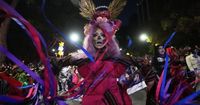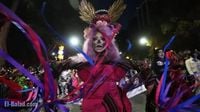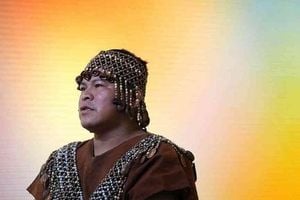On a bright October afternoon in Mexico City, the streets pulsed with color and music as thousands gathered for the annual Catrina parade, a prelude to the Day of the Dead festivities. Among the swirling sea of skeleton face paint and elaborate costumes, one group stood out: the LGBTQ+ collective Exóticas, whose nearly 200 artists, stylists, and designers brought their own vibrant twist to a cherished Mexican tradition.
Drag artist Ángel Arumir, resplendent in a pink dress inspired by Mexican folk art and crowned with purple flowers, adjusted his wig before joining the throng. For Arumir, 42, who has spent almost two decades performing in drag, the parade was more than just spectacle. "This day is our chance to show our art and our hearts with dignity," he told The Associated Press. "It has been difficult to gain our place in events related to our traditions."
Exóticas was just one of more than 40 groups marching this year, each promoting a unique social cause. Some collectives called for justice for Mexico’s disappeared, others celebrated pre-Hispanic traditions, while fans of various music genres danced in the streets. But for Arumir and his fellow LGBTQ+ performers, the event offered something rare: a moment of safety and solidarity in a country where discrimination and violence against their community remain alarmingly high.
The Catrina parade, which began in 2014 as a small gathering led by makeup artist Jessica Esquivias, has blossomed into one of Mexico City’s largest Day of the Dead events, drawing tens of thousands of participants and spectators downtown. It’s a relatively new tradition, but its roots stretch deep into Mexican culture. The Catrina herself—a skeleton often dressed in elegant clothing—was first illustrated by artist José Guadalupe Posada in the early 1900s. Originally a satirical jab at Mexico’s upper class and their European pretensions, the Catrina has since become an iconic symbol of the Day of the Dead, a reminder that death makes equals of us all.
The Day of the Dead holiday, which begins on October 31 and concludes on November 2, is a time to honor those who have passed. Each day is dedicated to different groups: those who died in accidents, children, and finally adults. The parade, held on October 26 this year, is a kaleidoscopic celebration of life and remembrance—a perfect stage for Exóticas to express both their artistry and their advocacy.
Preparation for the parade is a year-round labor of love. Between day jobs and family responsibilities, Arumir and his team sketch designs, sew costumes, and experiment with makeup. Each outfit is a one-of-a-kind creation, bursting with color and meaning. Some costumes carry powerful messages: Rich González, who traveled from Tijuana, wore black with colorful crosses cascading down the train of a skeleton figure, memorializing LGBTQ+ victims of cartel violence in his hometown.
For many in the LGBTQ+ community, especially transgender women, the parade is a rare opportunity to be visible and celebrated. But that visibility comes with risks. According to Sin Violencia LGTBQ+, a regional network that tracks violence against queer people, more than 80 LGBTQ+ individuals were murdered in Mexico last year—making it the second deadliest country in Latin America and the Caribbean for the community, after Colombia. Transgender women accounted for 55 of those deaths.
Activist Jair Martínez, part of the Sin Violencia LGTBQ+ network, explained to El Balad that the surge in violence is closely tied to the community’s increasing visibility. "Before, many of these women worked in clandestine spaces," Martínez said. "Now they have more exposure in public and that could explain why we’ve seen more violence towards them." The statistics are sobering, but for Arumir and his peers, the parade is a defiant act of joy and resilience.
"I want Exóticas to be an inclusive space where anyone can join and be themselves in freedom and safety," Arumir told The Associated Press. His words echoed in the laughter and dancing that filled the parade route, as participants moved to the rhythms of traditional Latino pop songs. Onlookers lined the sidewalks, snapping photos and smiling at the dazzling display.
For first-time marcher Santiago Mercado, 18, the experience was transformative. "This is a chance to celebrate our culture in a space where we can keep fighting for our rights," he said. The parade, with its blend of tradition and activism, offered a sense of belonging and hope for the future.
The Catrina parade’s evolution mirrors broader shifts in Mexican society. When Esquivias first organized the event, it was partly a response to the growing commercialization of Halloween and a desire to reclaim Mexican cultural symbols. Today, the parade is a platform for a multitude of voices—each group adding its own rhythm, color, and message to the city’s streets.
While the Day of the Dead is rooted in honoring the departed, the parade is equally about celebrating those who are still here, fighting for recognition and acceptance. As Arumir and the Exóticas collective marched alongside mothers seeking justice for the disappeared and other social groups, they demonstrated that tradition and progress can walk hand in hand.
The Catrina herself, born from satire more than a century ago, now stands as a symbol of both defiance and unity. For the LGBTQ+ community, she represents the right to exist openly and joyfully, even in the face of adversity. Each brushstroke of makeup, each stitch in a costume, is an act of remembrance and resistance—a way to honor those lost to violence while celebrating the beauty and diversity of life.
As the sun set on Mexico City, the echoes of music and laughter lingered in the air. The parade may last only a day, but its impact—on those who march and those who watch—endures much longer. Through creativity, solidarity, and a refusal to be silenced, Mexico’s LGBTQ+ community continues to carve out a place for itself in the country’s most cherished traditions.
In the heart of Mexico City, the Catrina parade remains a vivid testament to the power of art, remembrance, and the ongoing fight for equality. As Arumir and his fellow performers proved, sometimes the most powerful way to honor the dead is to live—and celebrate—without fear.





